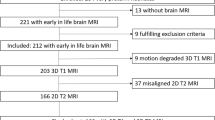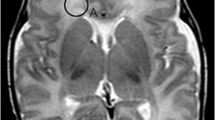Abstract
Objectives
This study aimed to apply a radiomics approach to predict poor psychomotor development in preterm neonates using brain MRI.
Methods
Prospectively enrolled preterm neonates underwent brain MRI near or at term-equivalent age and neurodevelopment was assessed at a corrected age of 12 months. Two radiologists visually assessed the degree of white matter injury. The radiomics analysis on white matter was performed using T1-weighted images (T1WI) and T2-weighted images (T2WI). A total of 1906 features were extracted from the images and the minimum redundancy maximum relevance algorithm was used to select features. A prediction model for the binary classification of the psychomotor developmental index was developed and eightfold cross-validation was performed. The diagnostic performance of the model was evaluated using the AUC with and without including significant clinical and DTI parameters.
Results
A total of 46 preterm neonates (median gestational age, 29 weeks; 26 males) underwent brain MRI (median corrected gestational age, 37 weeks). Thirteen of 46 (28.3%) neonates showed poor psychomotor outcomes. There was one neonate among 46 with moderate to severe white matter injury on visual assessment. For the radiomics analysis, twenty features were selected for each analysis. The AUCs of prediction models based on T1WI, T2WI, and both T1WI and T2WI were 0.925, 0.834, and 0.902. Including gestational age or DTI parameters did not improve the prediction performance of T1WI.
Conclusions
A radiomics analysis of white matter using early T1WI or T2WI could predict poor psychomotor outcomes in preterm neonates.
Key Points
• Radiomics analysis on T1-weighted images of preterm neonates showed the highest diagnostic performance (AUC, 0.925) for predicting poor psychomotor outcomes.
• In spite of 45 of 46 neonates having no significant white matter injury on visual assessment, the radiomics analysis of early brain MRI showed good diagnostic performance (sensitivity, 84.6%; specificity, 78.8%) for predicting poor psychomotor outcomes.
• Radiomics analysis on early brain MRI can help to predict poor neurodevelopmental outcomes in preterm neonates.




Similar content being viewed by others
Abbreviations
- AUC:
-
Area under the curve
- FA:
-
Fractional anisotropy
- GLCM:
-
Gray level co-occurrence matrix
- GLDM:
-
Gray level dependence matrix
- GLRLM:
-
Gray level run length matrix
- GLSZM:
-
Gray level size zone matrix
- GM:
-
Gray matter
- LoG:
-
Laplacian of Gaussian-filtered
- MRMR:
-
Minimum redundancy maximum relevance
- PDI:
-
Psychomotor development index
- PLIC:
-
Posterior limbs of internal capsule
- ROC:
-
Receiver operating characteristics
- ROI:
-
Region of interest
- T1WI:
-
T1-weighted image
- T2WI:
-
T2-weighted image
- WM:
-
White matter
References
Behrman RE, Butler AS (2007) Preterm birth: causes, consequences, and prevention. Washington, DC: National Academies Press (US)
Lee AC, Katz J, Blencowe H et al (2013) National and regional estimates of term and preterm babies born small for gestational age in 138 low-income and middle-income countries in 2010. Lancet Glob Health 1:e26–e36
Marlow N, Wolke D, Bracewell MA, Samara M (2005) Neurologic and developmental disability at six years of age after extremely preterm birth. N Engl J Med 352:9–19
Fanaroff AA, Stoll BJ, Wright LL et al (2007) Trends in neonatal morbidity and mortality for very low birthweight infants. Am J Obstet Gynecol 196:147.e1–147.e8
Saigal S, Doyle LW (2008) An overview of mortality and sequelae of preterm birth from infancy to adulthood. Lancet 371:261–269
Larroque B, Ancel PY, Marret S et al (2008) Neurodevelopmental disabilities and special care of 5-year-old children born before 33 weeks of gestation (the EPIPAGE study): a longitudinal cohort study. Lancet 371:813–820
Latal B (2009) Prediction of neurodevelopmental outcome after preterm birth. Pediatr Neurol 40:413–419
Ramey CT, Bryant DM, Wasik BH, Sparling JJ, Fendt KH, LaVange LM (1992) Infant Health and Development Program for low birth weight, premature infants: program elements, family participation, and child intelligence. Pediatrics 89:454–465
Woodward LJ, Anderson PJ, Austin NC, Howard K, Inder TE (2006) Neonatal MRI to predict neurodevelopmental outcomes in preterm infants. N Engl J Med 355:685–694
Woodward LJ, Clark CA, Bora S, Inder TE (2012) Neonatal white matter abnormalities an important predictor of neurocognitive outcome for very preterm children. PLoS One 7:e51879
Van’t Hooft J, van der Lee JH, Opmeer BC et al (2015) Predicting developmental outcomes in premature infants by term equivalent MRI: systematic review and meta-analysis. Syst Rev 4:71
Roze E, Benders MJ, Kersbergen KJ et al (2015) Neonatal DTI early after birth predicts motor outcome in preterm infants with periventricular hemorrhagic infarction. Pediatr Res 78:298–303
Ullman H, Spencer-Smith M, Thompson DK et al (2015) Neonatal MRI is associated with future cognition and academic achievement in preterm children. Brain 138:3251–3262
Guo T, Duerden EG, Adams E et al (2017) Quantitative assessment of white matter injury in preterm neonates: association with outcomes. Neurology 88:614–622
Cayam-Rand D, Guo T, Grunau RE et al (2019) Predicting developmental outcomes in preterm infants: a simple white matter injury imaging rule. Neurology 93:e1231–e1240
Chau V, Synnes A, Grunau RE, Poskitt KJ, Brant R, Miller SP (2013) Abnormal brain maturation in preterm neonates associated with adverse developmental outcomes. Neurology 81:2082–2089
Gillies RJ, Kinahan PE, Hricak H (2016) Radiomics: images are more than pictures, they are data. Radiology 278:563–577
Kim HG, Choi JW, Han M, Lee JH, Lee HS (2020) Texture analysis of deep medullary veins on susceptibility-weighted imaging in infants: evaluating developmental and ischemic changes. Eur Radiol 30:2594–2603
Sun H, Chen Y, Huang Q et al (2018) Psychoradiologic utility of MR imaging for diagnosis of attention deficit hyperactivity disorder: a radiomics analysis. Radiology 287:620–630
Liu Y, Jordan JT, Bredella MA et al (2020) Correlation between NF1 genotype and imaging phenotype on whole-body MRI: NF1 radiogenomics. Neurology 94:e2521–e2531
Patra K, Greene MM, Patel AL, Meier P (2016) Maternal education level predicts cognitive, language, and motor outcome in preterm infants in the second year of life. Am J Perinatol 33:738–744
Benavente-Fernández I, Synnes A, Grunau RE et al (2019) Association of socioeconomic status and brain injury with neurodevelopmental outcomes of very preterm children. JAMA Netw Open 2:e192914
Zöllei L, Iglesias JE, Ou Y, Grant PE, Fischl B (2020) Infant FreeSurfer: an automated segmentation and surface extraction pipeline for T1-weighted neuroimaging data of infants 0-2 years. Neuroimage 218:116946
de Macedo Rodrigues K, Ben-Avi E, Sliva DD et al (2015) A FreeSurfer-compliant consistent manual segmentation of infant brains spanning the 0-2 year age range. Front Hum Neurosci 9:21
Arzoumanian Y, Mirmiran M, Barnes PD et al (2003) Diffusion tensor brain imaging findings at term-equivalent age may predict neurologic abnormalities in low birth weight preterm infants. AJNR Am J Neuroradiol 24:1646–1653
De Bruïne FT, Van Wezel-Meijler G, Leijser LM et al (2013) Tractography of white-matter tracts in very preterm infants: a 2-year follow-up study. Dev Med Child Neurol 55:427–433
van Griethuysen JJM, Fedorov A, Parmar C et al (2017) Computational radiomics system to decode the radiographic phenotype. Cancer Res 77:e104–e107
Seiffert C, Khoshgoftaar TM, Van Hulse J, Napolitano A (2008) RUSBoost: Improving classification performance when training data is skewed. 2008 19th International Conference on Pattern Recognition. https://doi.org/10.1109/ICPR.2008.4761297
Spittle AJ, Cheong J, Doyle LW et al (2011) Neonatal white matter abnormality predicts childhood motor impairment in very preterm children. Dev Med Child Neurol 53:1000–1006
Hong HS, Kim SS, Park GY (2020) MRI findings to predict neurodevelopmental outcomes in preterm infants near term-equivalent age. Investig Magn Reson Imaging 24:30–37
Gui L, Loukas S, Lazeyras F, Hüppi PS, Meskaldji DE, Borradori Tolsa C (2019) Longitudinal study of neonatal brain tissue volumes in preterm infants and their ability to predict neurodevelopmental outcome. Neuroimage 185:728–741
Zwanenburg A, Leger S, Vallières M, Löck S (2019) Image biomarker standardisation initiative. arXiv Prepr arXiv161207003
Shu Z, Xu Y, Shao Y, Pang P, Gong X (2020) Radiomics from magnetic resonance imaging may be used to predict the progression of white matter hyperintensities and identify associated risk factors. Eur Radiol 30:3046–3058
Takahashi T, Murata T, Omori M et al (2004) Quantitative evaluation of age-related white matter microstructural changes on MRI by multifractal analysis. J Neurol Sci 225:33–37
Shao Y, Chen Z, Ming S et al (2018) Predicting the development of normal-appearing white matter with radiomics in the aging brain: a longitudinal clinical study. Front Aging Neurosci 10:393
Lee SM, Choi YH, Cheon JE et al (2017) Image quality at synthetic brain magnetic resonance imaging in children. Pediatr Radiol 47:1638–1647
Acknowledgements
The authors thank Sun Mi Cho, Department of Psychiatry, Ajou University Hospital, for contributing data on neurodevelopmental outcomes.
Funding
This study has received funding from the National Research Foundation of Korea.
Author information
Authors and Affiliations
Corresponding author
Ethics declarations
Guarantor
The scientific guarantor of this publication is Seung Eun Jung, MD.
Conflict of interest
The authors of this manuscript declare no relationships with any companies, whose products or services may be related to the subject matter of the article.
Statistics and biometry
No complex statistical methods were necessary for this paper.
Informed consent
Written informed consent was obtained from all subjects (patients) in this study.
Ethical approval
Institutional Review Board approval was obtained.
Study subjects or cohorts overlap
Some study subjects have been previously reported in European Radiology titled “Texture analysis of deep medullary veins on susceptibility-weighted imaging in infants: evaluating developmental and ischemic changes.”
Methodology
• prospective
• prognostic study
• performed at one institution
Additional information
Publisher’s note
Springer Nature remains neutral with regard to jurisdictional claims in published maps and institutional affiliations.
Youwon Shin and Yoonho Nam are co-first authors. This work origination is at the Department of Radiology, Ajou University School of Medicine, Ajou University Medical Center, Yeongtong-gu, Suwon, Republic of Korea.
Supplementary information
ESM 1
(DOCX 147 kb)
Rights and permissions
About this article
Cite this article
Shin, Y., Nam, Y., Shin, T. et al. Brain MRI radiomics analysis may predict poor psychomotor outcome in preterm neonates. Eur Radiol 31, 6147–6155 (2021). https://doi.org/10.1007/s00330-021-07836-7
Received:
Revised:
Accepted:
Published:
Issue Date:
DOI: https://doi.org/10.1007/s00330-021-07836-7




